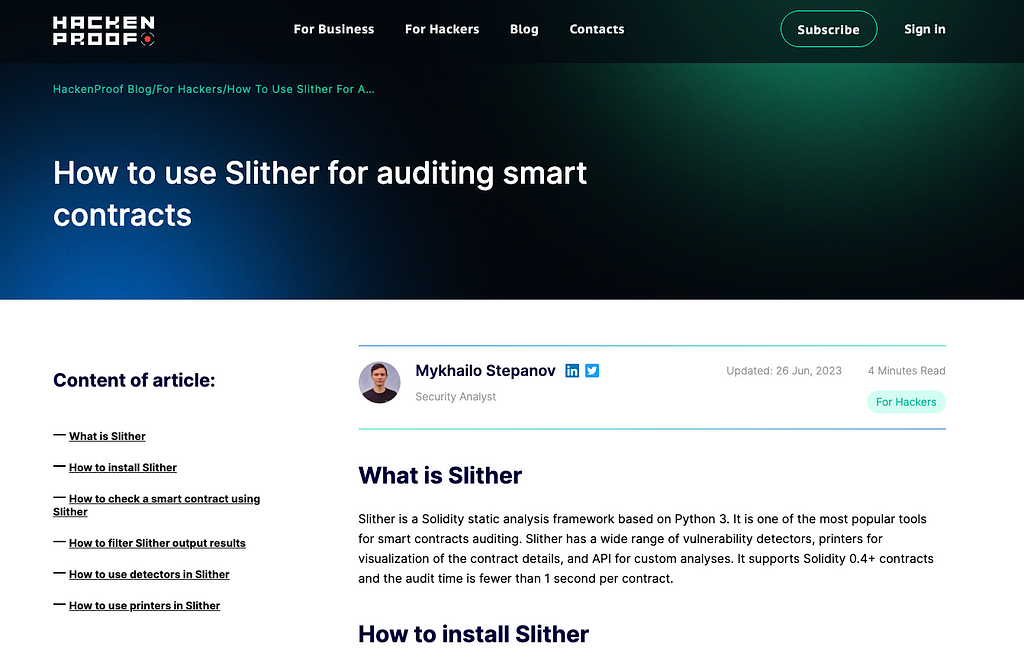Audit a Smart Contract: 101 Guide
 Photo by GuerrillaBuzz on Unsplash
Photo by GuerrillaBuzz on UnsplashSmart contract auditing is the process of carefully reviewing and analyzing a smart contract's code, logic, and functionality to identify potential vulnerabilities, security flaws, and areas for improvement.
With this 101 guide, you will learn the significance of smart contract auditing, explore practical tips and tools for conducting audits, and provide valuable insights to help you ensure the security and reliability of your blockchain applications.
Smart ContractsFirst, let's explain smart contracts. Smart contracts are self-executing digital agreements stored and executed on a blockchain network like Ethereum.
They are designed to automatically enforce a contract's terms and conditions without a central authority or intermediary.
Smart contracts are written in programming languages like Solidity, Vyper, or Rust and can facilitate a wide range of transactions, from simple token transfers to complex decentralized finance (DeFi) applications.
The demand for secure and reliable smart contracts has remained unchanged as the blockchain ecosystem grows.
Smart Contract AuditingAuditing a smart contract is extremely important for various reasons, such as to ensure its security, functionality, and reliability.
It helps identify potential vulnerabilities, bugs, or flaws that could be exploited by malicious actors, ultimately protecting investors and users.
Security: Smart contracts manage and secure valuable digital assets like cryptocurrencies, tokens, and other blockchain-based resources.
Any vulnerabilities or security flaws in the contract's code can lead to devastating consequences, such as theft, loss of funds, or system exploits.
Functionality: A thorough audit ensures the smart contract functions as intended, with all the necessary features and logic implemented correctly.
This helps to prevent unintended or unexpected behaviors that could compromise the contract's performance or user experience.
Compliance: Many blockchain applications operate in regulated industries or jurisdictions where compliance with applicable laws and regulations is essential.
Smart contract auditing can help ensure the contract's code and functionality align with these requirements.
Audience Trust: A comprehensive smart contract audit can help build trust and confidence among users, investors, and stakeholders in the blockchain ecosystem.
This is particularly important for projects seeking to attract mainstream adoption and institutional investment.
Next, here is an example code snippet of a smart contract audit:
// SPDX-License-Identifier: MITpragma solidity ^0.8.0;contract SimpleSmartContract {
address public owner; constructor() {
owner = msg.sender;
} modifier onlyOwner() {
require(msg.sender == owner, "Only the owner can call this function");
_;
} function withdraw(uint amount) public onlyOwner {
require(amount > 0, "Amount must be greater than 0");
payable(owner).transfer(amount);
} receive() external payable {}
}
In the example above, a simple, smart contract in Solidity. The contract includes a constructor to set the owner's address, a modifier onlyOwner to restrict access to certain functions, a withdraw function that allows the owner to withdraw funds, and a fallback function to receive payments.
This code can be audited for security vulnerabilities and best practices before deployment on the blockchain.
The Smart Contract Auditing ProcessAuditing a smart contract involves many steps, each designed to examine the contract's code, logic, and security. Next, a detailed overview of the steps involved:
1. Initial Report and Scope DefinitionThe first step in the auditing process is to gather information about the smart contract and define the scope of the audit. This includes:
Contract Overview: Obtain a detailed understanding of the contract purpose, functionality, and the specific blockchain network it operates on (e.g., Ethereum, Solana, Binance Smart Chain).
Codebase Review: Examine the contractor's codebase, including any dependencies or external libraries used.
Documentation Review: Review any available documentation, such as the contract's whitepaper, technical specifications, or user guides.
Scope Definition: Based on the project's requirements and the identified risks, determine the specific areas of the contract that need to be audited.
The outcome of this step is an initial report that outlines the project's details, the agreed-upon scope, and the timeline for the audit.
2. Manual Code ReviewThe next step is a manual review of the contract's code. This involves:
Code Inspection: Carefully examine the contract's code line by line to identify potential vulnerabilities, logic flaws, and areas for improvement.
Control Flow Analysis: Analyze the contract's control flow to ensure that the logic is implemented correctly and that there are no unintended execution paths.
Data Flow Analysis: Examine how data is handled and stored within the contract, looking for potential data manipulation or leakage issues.
Function Testing: Thoroughly test each function within the contract to ensure that it behaves as expected and does not introduce any security risks.
During the manual review, the auditing team will also assess the contract's adherence to best practices, coding standards, and industry-recognized security guidelines.
3. Automated Analysis and Tool-Assisted AuditingIn addition to the manual code review, the auditing process often involves using specialized tools and automated analysis techniques. These include:
Smart Contract Audit Tools: Utilize industry-leading tools, such as Mythril, Slither, or Remix, to perform static and dynamic code analysis, identify common vulnerabilities, and generate detailed reports.
 How to use Slither for auditing smart contracts
How to use Slither for auditing smart contractsFormal Verification: Apply formal verification techniques, such as mathematical modeling and theorem proving, to validate the contract's correctness and security properties rigorously.
Fuzzing and Penetration Testing: Conduct extensive testing, including fuzzing (automated input generation) and penetration testing, to uncover potential vulnerabilities or unexpected contract behavior.
The combination of manual review and automated analysis provides a comprehensive approach to identifying and addressing smart contract security issues.
4. Reporting and RemediationAfter thoroughly examining the smart contract, the auditing team will compile a detailed report outlining the findings. This report typically includes:
Summary of Findings: A high-level overview of the identified vulnerabilities, issues, and areas for improvement.
Vulnerability Classifications: A categorization of the discovered vulnerabilities based on their severity and potential impact.
Remediation Recommendations: Specific recommendations and guidance for addressing the identified issues, including suggested code changes or architectural modifications.
Attestation and Certification: If the contract is deemed secure and compliant, the auditing team may provide a formal attestation or certification to validate the contract's integrity.
The report is a valuable resource for the smart contract development team, allowing them to prioritize and address the identified issues before the contract is deployed or released to the public.
5. Continuous Monitoring and Ongoing AuditsSmart contract auditing is ongoing as the blockchain ecosystem and contracts constantly evolve. After the initial audit, it is essential to maintain a robust monitoring and auditing strategy, which includes:
Regular Audits: Scheduling periodic audits by the same auditing team or a different provider to ensure the contract remains secure and up-to-date.
It is monitoring for Changes: Closely monitoring the contract's codebase and the underlying blockchain network for any updates or changes that may impact the contract's security or functionality.
Incident Response: Establishing a clear incident response plan to quickly address identified vulnerabilities or security breaches, minimizing the potential impact on users and stakeholders.
Adopting a continuous auditing approach can help maintain the integrity and reliability of your smart contracts throughout their lifecycle.
Smart Contract VulnerabilitiesSmart contracts, like any other software, can be susceptible to various vulnerabilities.
 OWASP Smart Contract Top 10
OWASP Smart Contract Top 10These common vulnerabilities are needed for conducting effective audits and implementing robust security measures. Some of the most prevalent smart contract vulnerabilities are:
Reentrancy Attacks: This vulnerability occurs when a malicious contract can repeatedly call a function in the target contract before the initial call is completed, potentially draining the contract's resources.
Arithmetic Overflow/Underflow: Smart contracts that perform arithmetic operations without proper checks can be vulnerable to integer overflow or underflow, leading to unexpected behavior or fund loss.
Unauthorized Access: Improper access control mechanisms can allow unauthorized parties to execute sensitive functions or access restricted resources within the smart contract.
Unprotected Selfdestruct: The selfdestruct function in Ethereum can be misused to terminate a contract and potentially steal its assets prematurely.
Lack of Input Validation: Insufficient validation of user inputs can lead to vulnerabilities like SQL injection, cross-site scripting (XSS), or other injection attacks.
Incorrect Use of Randomness: Generating randomness in a smart contract can be challenging, and improper implementation can lead to vulnerabilities that can be exploited.
Denial of Service (DoS): Smart contracts can be susceptible to DoS attacks, where an attacker can prevent the contract from functioning correctly by exhausting its resources.
Incorrect Handling of Exceptions: Improper handling of exceptions and error conditions can lead to unexpected contract behavior or even contract failure.
These common vulnerabilities require appropriate security measures during auditing to ensure smart contracts' overall security and reliability.
Smart Contract Auditing ToolsSeveral tools and resources are available to assist with the auditing process, including those that can help identify and address smart contract vulnerabilities.
Some of the most widely used tools include:
Mythril: is a security analysis tool for Ethereum smart contracts that detect vulnerabilities, including reentrancy, integer overflow/underflow, and more.
Slither: is a static analysis framework for Solidity smart contracts that can identify common security issues, design patterns, and code complexity.
Remix: An Integrated Development Environment (IDE) for Ethereum includes a built-in static analysis tool and a debugger to help identify and fix contract issues.
Truffle Suite: A development environment, testing framework, and asset pipeline for Ethereum, which includes tools for automated testing and deployment.
Hardhat: is an Ethereum development environment that provides a suite of tools, including a testing environment, static analysis, and deployment capabilities.
In addition to these tools, various resources can help you stay up-to-date with the latest smart contract security best practices, vulnerabilities, and industry developments. Some of these resources include:
Smart Contract Security Best Practices: Guides and resources from organizations like the Ethereum Foundation, OpenZeppelin, and the Blockchain Security Community.
Smart Contract Vulnerability Databases: Repositories like the Consensys Diligence Smart Contract Weakness Registry and the Ethereum Smart Contract Weakness Classification and Test Cases.
 Smart Contract Weakness Classification (SWC)Please note that this content is no longer actively maintained.
Smart Contract Weakness Classification (SWC)Please note that this content is no longer actively maintained. 